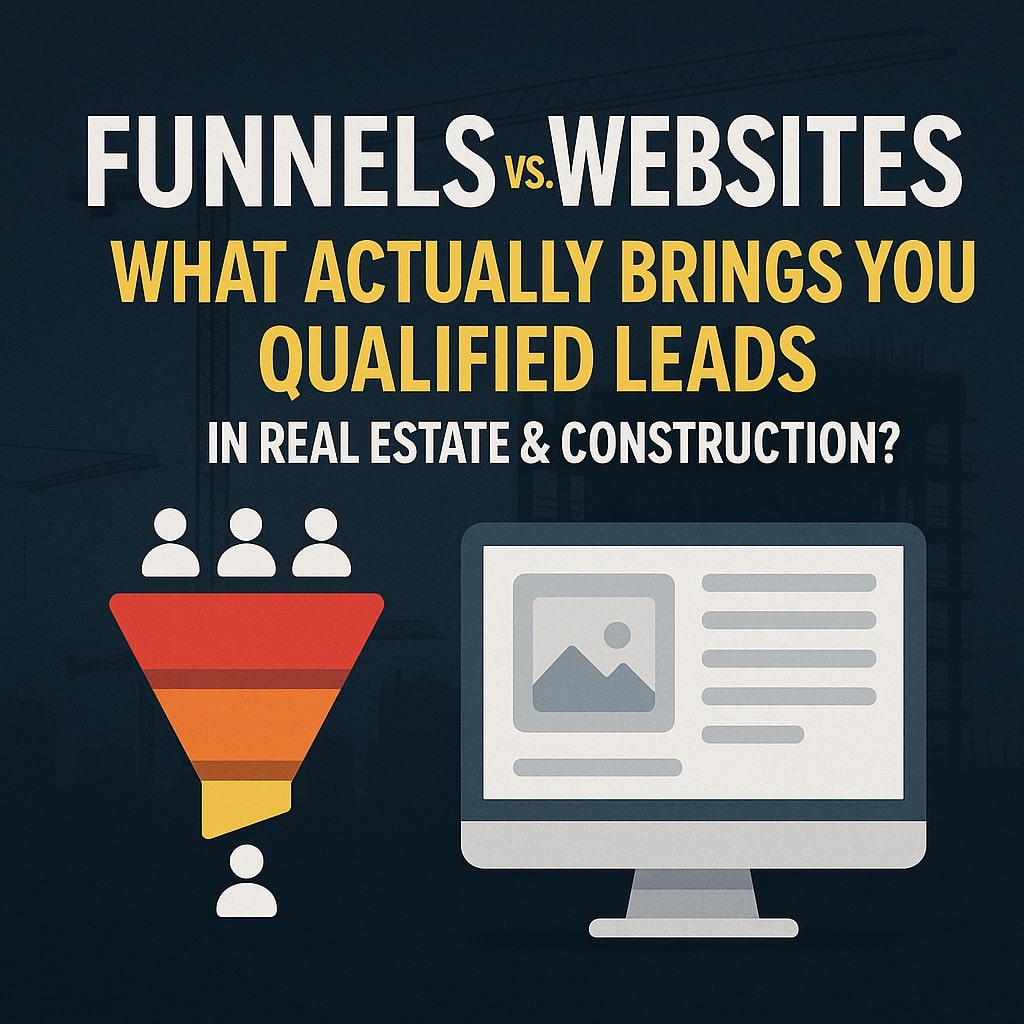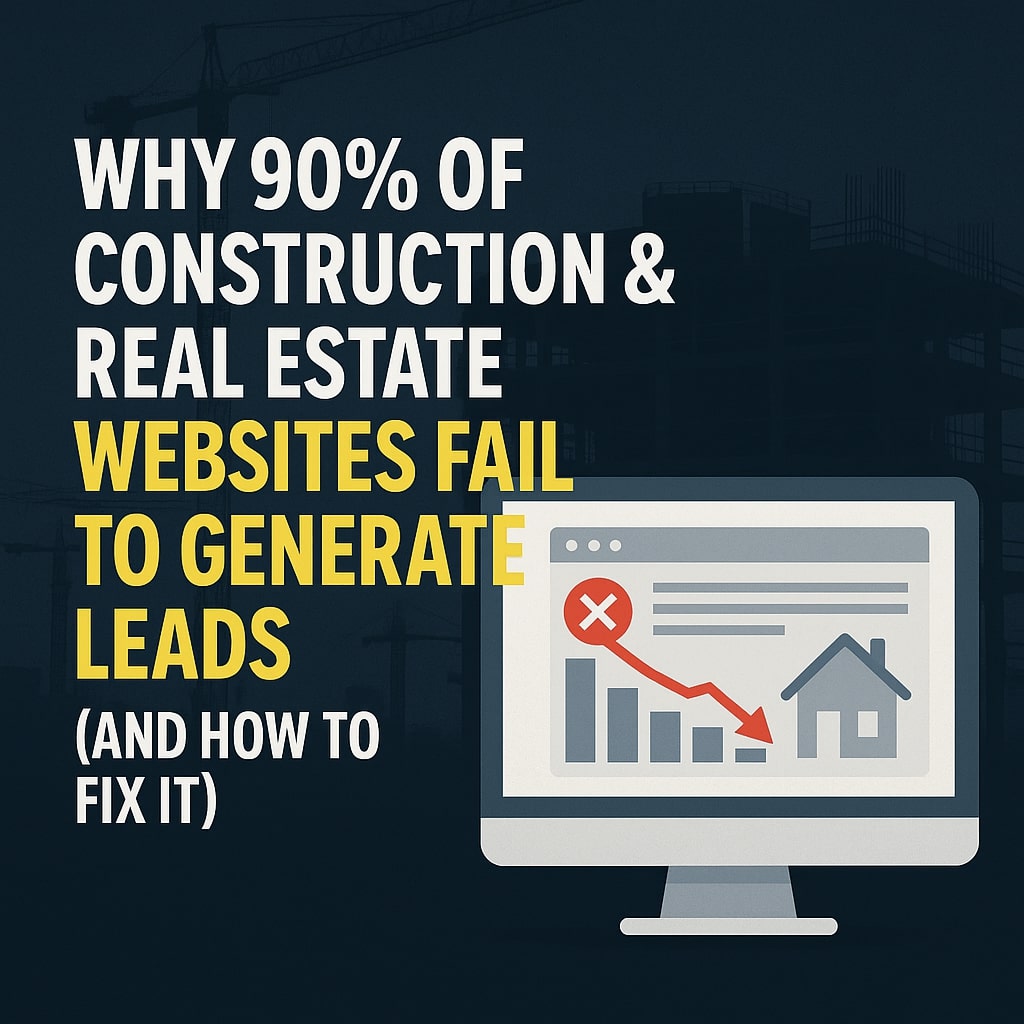Funnels vs. Websites: What Actually Brings You Qualified Leads in Real Estate & Construction?

Real estate and construction businesses are finally waking up to a truth digital marketers have known for years — a website alone isn’t enough to generate consistent, qualified leads.
Most developers, builders, and realtors invest thousands of dollars in beautifully designed websites. They look professional, include every service, and even have impressive portfolios. But months later, they’re still asking the same question:
“Why aren’t we getting leads?”
The answer lies in understanding the difference between a website and a funnel — and knowing when to use each.
The Purpose of a Website
A website acts as your digital headquarters.
It’s where prospects go to learn about your brand, explore your services, and verify your credibility.
Think of it as your online brochure or showroom.
It provides a complete overview — who you are, what you do, and why people should trust you.
A good website for a real estate or construction business should:
- Build authority and trust.
- Showcase your portfolio and past projects.
- Provide company information, credentials, and contact details.
- Support SEO efforts for long-term visibility.
But here’s the problem: most websites stop there.
They’re designed to inform — not to convert.
The Purpose of a Funnel
A funnel is built for one thing only — conversion.
While a website spreads attention across multiple pages, a funnel guides visitors step-by-step toward a specific action, such as:
- Booking a consultation.
- Requesting a quote.
- Downloading a project guide or brochure.
- Registering for an open house or property preview.
Every element in a funnel — the headline, form, button, image, and layout — has a single goal: move the visitor to the next step in the journey.
You could say:
A website educates.
A funnel converts.
Why Most Real Estate and Construction Websites Fail
Let’s be honest. Many industry websites look stunning but perform poorly.
They win design awards but lose business.
Here’s why:
- They lack a clear call to action (CTA).
- Navigation is cluttered with too many menu items.
- Pages are filled with jargon instead of benefits.
- There’s no lead capture form above the fold.
- Visitors leave because they don’t know what to do next.
Imagine spending thousands on ads or SEO traffic, only to send people to a homepage with no direction. That’s like hosting an open house and forgetting to tell visitors where to sign in.
Websites Attract, Funnels Convert
Think of it this way — your website attracts people through SEO, ads, and social media.
Your funnel converts them into leads once they arrive.
Here’s an example:
- A prospect searches “residential builder in Austin.”
- They find your website through Google.
- They click on a page that speaks to their exact need — “custom home design.”
- The page includes a clear offer: “Book a Free 30-Minute Project Consultation.”
That simple shift — from information to invitation — transforms your website traffic into leads.
Funnel Anatomy: What Makes It Work
A high-performing funnel has three essential parts:
1. The Hook
This is your headline — the first thing visitors see.
It must instantly connect with their need or desire.
Example:
“Planning a New Home? Get a Free 3D Design Concept Before You Build.”
The hook grabs attention and makes people want to learn more.
2. The Value
Once you have attention, you must provide value.
That could be a project calculator, a downloadable guide, or a free consultation.
Example:
“Download our guide: 7 Mistakes to Avoid When Choosing a Contractor.”
This positions you as a helpful and trustworthy individual.
3. The Action
Finally, the funnel guides users to take one simple step — usually filling out a form or booking a call.
Keep it friction-free: ask for only the essentials (name, phone, email, project type).
Too many fields kill conversions.
Funnels in Action: Real Examples
Example 1: Construction Company
A regional contractor created a landing page offering a “Free Cost Estimate in 24 Hours.”
The page had one goal — get visitors to request a quote.
They promoted it through local Google Ads and social media.
Within 60 days, it generated three times as many inquiries as their website’s contact page had in an entire year.
Example 2: Real Estate Developer
A developer built a funnel for a new apartment project.
Instead of sending people to a generic homepage, they ran Facebook ads to a landing page with:
- A project overview video.
- A short form: “Book a Private Walk-Through.”
The result?
Leads were 40% more qualified and closed faster because they’d already seen visuals and details before meeting the sales team.
Key Differences Between a Website and a Funnel
| Feature | Website | Funnel |
|---|---|---|
| Goal | Educate & inform | Convert & capture leads |
| Structure | Multi-page navigation | Linear, step-by-step flow |
| Focus | Building credibility, SEO, and brand awareness | Narrow — one offer or action |
| User Path | Visitors choose their path | You guide them through one path |
| Best For | Building credibility, SEO, brand awareness | Broad — about the company, services, etc. |
Why Real Estate & Construction Need Both
You don’t have to choose between a website and a funnel — you need both working together.
- Your website builds trust and authority.
- Your funnel captures leads and drives action.
Together, they form a system:
Your ads, SEO, and social media bring traffic → your funnel converts that traffic into calls, inquiries, and meetings.
For example, a builder might:
- Use a website to show their brand, past projects, and testimonials.
- Link ads or posts directly to a funnel offering a “Free Site Visit” or “Project Cost Estimate.”
- Follow up automatically with an email or WhatsApp message.
This combination builds credibility first, then drives measurable results.
Why Funnels Convert Better
Funnels outperform websites in conversion rates because they remove distractions.
There’s only one direction to go — forward.
A visitor can’t wander through service pages, blog posts, or galleries. They focus on your message and your offer.
Studies across industries show that well-optimized funnels can improve lead conversion by 200–300% compared to standard websites.
That’s especially true in real estate and construction, where decisions involve high trust and large budgets.
When you control the journey, you control the outcome.
Common Funnel Mistakes to Avoid
Even good funnels can fail when executed poorly. Avoid these pitfalls:
- Too much text: Keep it short and benefit-driven.
- No visuals: Include real project photos or short videos.
- Weak offer: Make your CTA compelling — “Get a Free Estimate” beats “Contact Us.”
- Long forms: Fewer fields = more conversions.
- No follow-up: Set up email or message automation to nurture cold leads.
Your funnel should feel like a one-on-one conversation — simple, direct, and human.
Building a Simple Funnel for Your Business
Here’s a basic funnel you can set up this week:
- Landing Page – One focused headline, one offer, one CTA.
Example: “Build Your Dream Home in Dallas — Get a Free Site Consultation.” - Thank-You Page – Confirm the action and show your next step (booking link, video, or brochure).
- Follow-Up Email/Message – Send a thank-you note and deliver value (project guide, cost breakdown, or free tips).
- Retargeting Ads – Display follow-up ads to visitors who didn’t convert during their initial visit.
This simple setup can outperform a whole website in generating qualified leads.
The Real Secret: Strategy, Not Software
Funnels work not because of fancy tools, but because of strategy.
You can use WordPress, ClickFunnels, HubSpot, or any builder you like.
What matters is the psychology behind it — clarity, relevance, and trust.
Before creating a funnel, ask yourself:
- What’s the one action I want visitors to take?
- What pain point am I solving?
- What offer will motivate them to act now?
Answer those questions clearly, and your funnel will outperform most websites within a short period.
Final Takeaway
The debate between funnels and websites isn’t about choosing one over the other — it’s about using each for the right purpose.
Your website establishes credibility and helps you rank in search results.
Your funnel drives action and turns visitors into qualified leads.
In real estate and construction, where trust and timing are everything, the businesses that master both win.
So here’s your action plan:
- Audit your current website.
- Identify the key service or project type that needs more leads.
- Build a simple funnel around it — one landing page, one offer, one CTA.
Once it’s live, drive traffic to it through local SEO, Google Ads, or social posts.
Measure results, optimize, and scale.
Your next qualified lead isn’t coming from another website redesign.
It’s coming from a focused funnel that speaks directly to the right person — at the right time — with the right offer.

